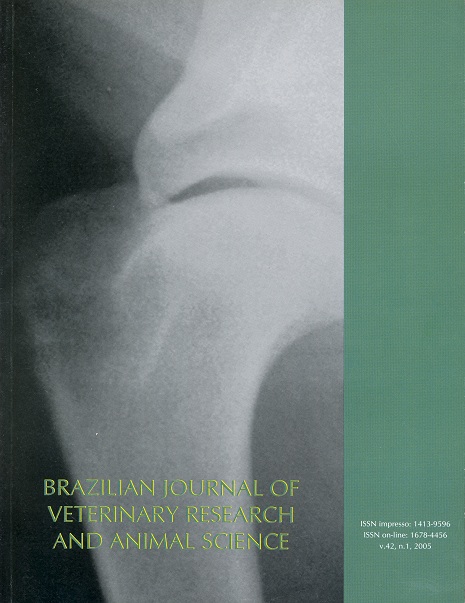Biometric and histopatogical alterations in testicles of collared peccary (Tayassu tajacu) created in captivity in the semi-arid Northeasterner, Brazil
DOI:
https://doi.org/10.11606/issn.1678-4456.bjvras.2005.26449Keywords:
Collared peccary, Testicular degeneration, Orchitis, RarefactionAbstract
This research was developed with the purpose to contribute with the information regarding biometric and pathological aspects in testicles of collared peccary (Tayassu tajacu). Twelve animals were used, with age superior than ten years, coming from the Center of Multiplication of Wild Animals CEMAS/ESAM. After the collection, the testicles were submitted to biometry and soon afterwards fixed in Bouin's solution. Later on, the samples were conserved in alcohol 70%, and underwent the routine histological processing. The reading of the lamina was accomplished in optical microscope and the obtained results were statistically analyzed through the T- and Z-tests. The medium values of the length, circumference and weight, among the right and left testicle, don't reveal statistical difference if the T-test is applied. However, the same test demonstrated a correlation with a significance of 1% probability among the right and left gonad, when comparing each biometric variable. Of the 12 used animals, eight (67%) presented testicular alterations, which corresponded to a degeneration (63%), epithelium rarefaction (25%) and orchitis (12%). Through the Z-test there was a significance of 2.5%, when the frequencies between degeneration and rarefaction were compared, as well as between degeneration and orchitis. It was verified that, when one of the testicle biometric variables presented a modification, there was a correspondence with the contralateral organ. The most frequent pathology was the testicular degeneration, which demonstrated correlation with the other alterations.Downloads
Download data is not yet available.
Downloads
Published
2005-02-01
Issue
Section
UNDEFINIED
License
The journal content is authorized under the Creative Commons BY-NC-SA license (summary of the license: https://
How to Cite
1.
Filgueira KD, Moura CEB de, Batista JS, Silva SMMS, Oliveira MF de, Albuquerque JFG de, et al. Biometric and histopatogical alterations in testicles of collared peccary (Tayassu tajacu) created in captivity in the semi-arid Northeasterner, Brazil. Braz. J. Vet. Res. Anim. Sci. [Internet]. 2005 Feb. 1 [cited 2024 Apr. 19];42(1):19-25. Available from: https://www.revistas.usp.br/bjvras/article/view/26449





